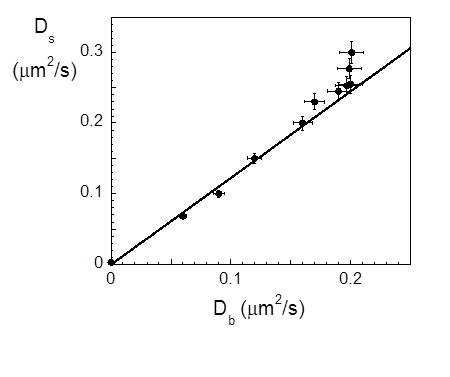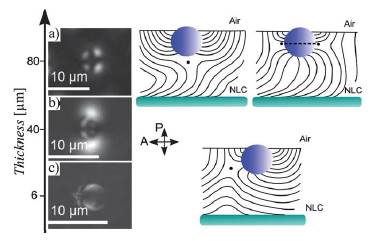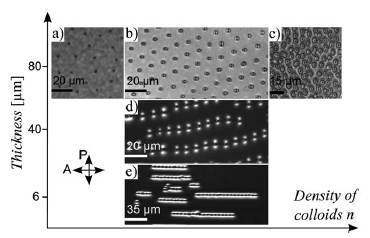Rechercher
Accueil > La Recherche > Axes & Equipes > Matière Molle & Verres > Equipe : Matière Molle > Thème : Interfaces complexes
Colloids at interface between complex fluids
publié le , mis à jour le
1. Colloids as probe of surface viscosity at complex fluid interfaces laden with soluble surfactants
People involved : M. Nobili, M. In, Stocco A., Ch. Blanc,
We use micro-rheology to assess the dynamical properties of Gemini-like surfactants adsorbed at an air/water surface. The used surfactant is soluble in water and self-assembles into worms-like micelles. We measure by particle tracking the particle diffusion coefficient over the interface and in the bulk phase for different surfactant concentrations C. Using Mirau interferometry we are able to measure the particle contact angle in situ for all surfactants concentrations. This technique allows to discriminate for the first time the effect of the particle partition at the interface from the one of the surface viscosity. Surface diffusion is governed by the bulk viscosity of the sub-phase in a large range of surfactant concentrations. Deviation from this behavior measured at low C can be ascribed to the variation of particle immersion as measured by Mirau interferometry, and to the transition from compressible to incompressible surface.

Dffusion coefficient of a probe microparticle at the air-solution interface poltted versus the Bulk Diffusion coefficient
2. Elastic interactions between colloids at a liquid crystal interface.
When one of the fluids is structured as in the case of a liquid crystal, elastic and defect mediated forces between the colloids appear. By optical tweezer and particle tracking we are able to measure the pair-wise interaction between silica particles trapped at a flat air/liquid crystal interface. The long-range asymptotic behaviour of the interaction is well fitted by a model we develop which takes just into account the nematic elasticity. This interaction is at the origin of the measured hexagonal patterns (see Figure below). At shorter distance the interaction is more complex being governed by defect transformation and recombination. These effects have drastic consequences : for example they transform the crystal pattern in a glassy structure.

Evolution of the birefringence pattern given by an isolated bead with the thickness of the nematic layer planarly anchored on the lower substrate. At large thicknesses (d >> 40 mm), a Maltese cross is observed (a) between crossed polarizers. At smaller thicknesses (d = 40 mm), an asymmetric pattern (b) is observed and a point defect progressively appears in thin layers (c). The sketches illustrate the possible nematic textures around the beads.

Patterns formed by 4 mm diameter beads trapped at the air/NLC interface when a strong planar anchoring is imposed by the lower substrate. At large thicknesses (d = 80 mm) the patterns strongly depend on the colloids density, going from a liquid (a) to a crystal (b) and anamorphous condensed state (c). When the thickness decreases (d = 40 mm), loose chains are observed (d) and at thin layers, well-defined chains along the easy axis collect the beads (e).
Reference :
- Behavior of colloidal particles at a nematic liquid crystal interface. M. A. Gharbi, M. Nobili, M. In, G. Prévot, P. Galatola, J.-B. Fournier and Ch. Blanc,
Soft Matter, 7, 1467 (2011). - Topological defects : A template to direct assembly of colloidal particles at nematic interfaces. M.A. Gharbi, M. Nobili and Ch. Blanc.
Journal of Colloid and Interface Science, 2014, 417, 250–255.








